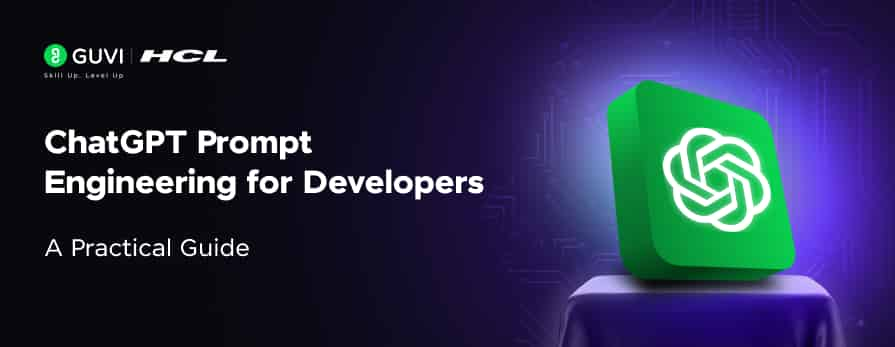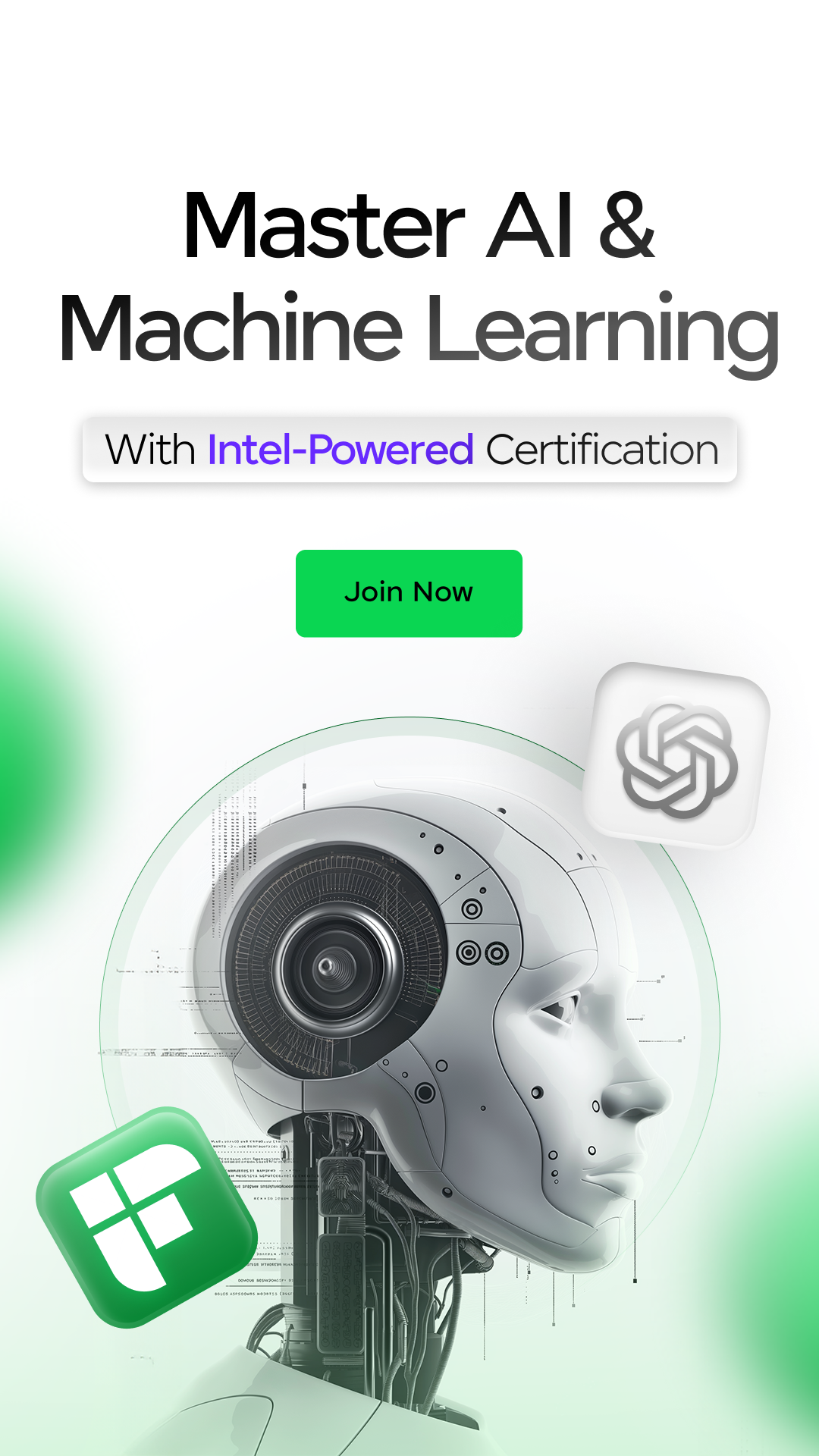
ChatGPT Prompt Engineering for Developers: A Practical Guide [2025]
Aug 26, 2025 6 Min Read 2828 Views
(Last Updated)
Wondering what the sudden craze for prompt engineering amongst coders is? ChatGPT prompt engineering for developers transforms AI interactions into powerful coding solutions for your development challenges. You can effectively direct AI to help write code, automate tasks, and learn new skills faster than ever before.
But there’s a lot to know and learn before you can try it yourself, and it can get pretty confusing and intensive. Hence, I’ve drafted this guide that covers everything you need to know about ChatGPT prompt engineering for developers, from fundamental concepts to advanced techniques. You’ll discover practical approaches for debugging, architecture design, and even platform integrations like Strapi v5.
The techniques presented apply across various development scenarios, making them valuable regardless of your specific coding focus. By the end, you’ll have the knowledge to craft prompts that consistently deliver precise, usable code solutions. Let’s begin!
Table of contents
- Understanding ChatGPT Prompt Engineering Basics
- 1) What is a ChatGPT prompt?
- 2) Why prompt clarity matters
- 3) Prompt engineering vs traditional coding
- Core Prompting Techniques for Developers
- 1) Using delimiters and structured formats
- 2) Few-shot vs zero-shot prompting
- 3) Asking ChatGPT to verify assumptions
- How to Develop an Iterative Prompt Development Process
- 1) Start with a rough prompt
- 2) Refine based on output
- 3) Test and validate results
- Practical Prompt Engineering Use Cases for Developers
- 1) Debugging and code review
- 2) Generating documentation
- 3) Creating test cases and mock data
- 4) Translating code between languages
- Advanced Prompting for Real Projects
- 1) Building custom chatbots
- 2) Designing system architecture with AI
- 3) Security and performance prompts
- 4) Integrating prompt workflows into CI/CD
- Concluding Thoughts…
- FAQs
- Q1. What is prompt engineering for ChatGPT?
- Q2. How can developers use ChatGPT for debugging code?
- Q3. What are some best practices for writing effective prompts?
- Q4. Can ChatGPT help with generating code documentation?
- Q5. How can prompt engineering be integrated into the software development workflow?
Understanding ChatGPT Prompt Engineering Basics
Understanding prompt engineering basics is essential for maximizing your interactions with AI models like ChatGPT. Mastering these fundamentals will help you communicate effectively with AI systems and get the results you need for your development projects.
![ChatGPT Prompt Engineering for Developers: A Practical Guide [2025] 1 chatgpt prompt engineering](https://www.guvi.in/blog/wp-content/uploads/2025/08/1@2x-1200x630.png)
1) What is a ChatGPT prompt?
A ChatGPT prompt is simply an instruction or query you enter into the AI chatbot’s interface to guide the conversation and receive specific responses. Essentially, it serves as the initial input that shapes how the model responds to your request. While prompts can be simple questions, you’ll get much better results by being specific and providing additional context that helps ChatGPT generate more useful outputs.
2) Why prompt clarity matters
Prompt clarity directly impacts the quality of responses you receive. When you craft clear, specific prompts, you reduce ambiguity and help the AI understand exactly what you’re requesting. Conversely, vague or poorly structured prompts often lead to:
- Unclear or ambiguous answers
- Inconsistent tone or style
- Generic or irrelevant information
3) Prompt engineering vs traditional coding
| Aspect | Traditional Coding | Prompt Engineering |
| Communication Style | Uses formal syntax and programming languages | Uses natural language to instruct AI |
| Error Tolerance | Low – small syntax errors can break the program | Probabilistic – the same input may yield different outputs |
| Execution | Deterministic – same input always gives the same output | Probabilistic – same input may yield different outputs |
| Required Skills | AI behavior understanding, NLP, and prompt refinement | AI behavior understanding, NLP, prompt refinement |
| Consistency | Coding languages, algorithms, and debugging | Less consistent; context and model behavior influence results |
| Use Cases | Ideal for structured, logic-heavy, or system-critical applications | Great for rapid prototyping, content generation, and iterative/creative tasks |
| Relationship | Standalone approach for building software | Complements coding; enhances productivity in dynamic and creative environments |
| Salary (India) | ₹4.5–25 LPA (varies by role: Frontend, Backend, Full Stack, etc.) | ₹8–35 LPA (higher for those with AI/ML + domain + NLP + product experience) |
Note: Prompt engineering is still an emerging role. Salaries are higher due to niche demand and overlap with AI/ML, product design, and language expertise. Traditional coding roles are broader and offer stable, scalable career paths.
Nevertheless, prompt engineering doesn’t replace traditional programming but rather complements it, particularly for rapid prototyping, content generation, and tasks where frequent requirement changes occur. Together, they represent a powerful toolkit for modern developers.
Core Prompting Techniques for Developers
Mastering core prompting techniques can dramatically improve your interactions with ChatGPT when developing software. These essential methods help you extract precisely what you need from the AI, whether you’re debugging code or designing architecture.
![ChatGPT Prompt Engineering for Developers: A Practical Guide [2025] 2 2@2x](https://www.guvi.in/blog/wp-content/uploads/2025/08/2@2x-1200x630.png)
1) Using delimiters and structured formats
Delimiters are special character sequences that separate different parts of your prompt, creating clear boundaries for the AI to follow. Specifically, they help prevent prompt confusion and make your instructions more explicit.
Common delimiter types include:
- Triple quotes (“””)
- Triple backticks (“`)
- Angle brackets (< >)
- Curly braces ({ })
- Square brackets ([ ])
- Pipes (|)
For instance, when asking ChatGPT to analyze code, you might structure your prompt like: “Debug the Python code delimited by triple backticks: [your code here]”
Delimiters are especially valuable when you need ChatGPT to distinguish between instructions and content. Moreover, they provide visual clarity that helps both you and the AI recognize different sections of your prompt. This organized approach leads to more accurate and relevant responses for your development tasks.
2) Few-shot vs zero-shot prompting
Zero-shot prompting means asking ChatGPT to perform a task without providing examples. This approach relies entirely on the model’s existing knowledge to generate responses. Zero-shot prompting works well when working with fine-tuned LLMs and when establishing performance baselines.
In contrast, few-shot prompting involves giving ChatGPT examples of what you want before asking for a similar output. This technique helps the model better understand the pattern you’re looking for.
Consider these approaches:
- Zero-shot: “Write a function that calculates the factorial of a number in Python.”
- Few-shot: “Here’s how to write a function that calculates the square of a number in Python:
def square(n):
return n*n
Now write a function that calculates the factorial of a number using the same style.”
Few-shot prompting generally produces more relevant responses because it adds to the model’s contextual understanding. Nevertheless, it typically requires more tokens, which can increase computation and latency. As a result, it may lead to higher costs when using the API.
3) Asking ChatGPT to verify assumptions
When working with ChatGPT, the model often makes assumptions to fill gaps in your prompts. Consequently, these assumptions can lead to inaccurate or misleading responses if not properly managed.
To address this issue, explicitly ask ChatGPT to identify its assumptions. For example: “Before answering, list any assumptions you’re making about the programming language, environment, or constraints.”
Another effective technique is to request verification of information: “If you’re not certain about specific steps for SOFTWARE-A, please indicate that your answer is an educated guess rather than from official documentation.”
This verification approach is particularly important for development tasks where precision matters. Furthermore, using inversion thinking—considering what could make your solution fail—can help identify critical assumptions in your prompt or the AI’s response.
Above all, remember that clear, structured prompts combined with these verification techniques will yield the most reliable results for your development projects.
How to Develop an Iterative Prompt Development Process
Developing effective prompts for ChatGPT is rarely a one-shot process. Prompt engineering requires iteration to achieve optimal results for your development projects. Following a structured approach helps you progressively improve your prompts and extract maximum value from AI interactions.
![ChatGPT Prompt Engineering for Developers: A Practical Guide [2025] 3 3@2x](https://www.guvi.in/blog/wp-content/uploads/2025/08/3@2x-1200x630.png)
1) Start with a rough prompt
Creating your initial prompt is just the beginning of the journey. Start with a basic version that outlines your core request:
- Define the basic task or question
- Include minimal necessary context
- Specify your desired output format
- Keep it simple
This baseline prompt serves as your starting point. During this phase, don’t worry about perfection – the goal is to establish a foundation you can build upon.
2) Refine based on output
Once you’ve received ChatGPT’s initial response, evaluate it critically and make targeted improvements:
After testing initial prompts and reviewing responses, adjust for greater specificity or clarity. If your first attempt produces generic or off-target answers, consider these refinement strategies:
- Add more specific parameters about the expected output format
- Include additional context about your use case
- Specify the role you want ChatGPT to assume
- Break complex requests into smaller, more manageable parts
This refinement process mirrors human conversation patterns, where understanding deepens with each exchange. Subsequently, you can build upon AI’s responses by adding follow-up instructions like “make it funnier” or “explain it to college students” without repeating all the context.
3) Test and validate results
Prior to finalizing your prompt, thoroughly test it under different conditions. This validation phase ensures your prompt performs consistently and produces accurate results:
- Try your prompt multiple times to check for consistency
- Test with slight variations to identify potential weaknesses
- Verify the technical accuracy of any code or specifications
- Compare outputs against your requirements
During testing, you might discover that “providing domain-specific information enhances dataset analysis”. Incorporate relevant technical context about your development environment or programming languages to improve results.
Thereafter, if you’re still experiencing issues, consider starting a new chat. According to experts, “When ChatGPT gets stuck on one approach, or keeps spouting a wrong answer… start a new session”. This fresh perspective often yields better results than continuing to refine a problematic conversation thread.
Practical Prompt Engineering Use Cases for Developers
Beyond theoretical understanding, ChatGPT prompt engineering for developers offers practical applications that can streamline your development workflow. Let’s explore how well-crafted prompts can tackle common development challenges.
![ChatGPT Prompt Engineering for Developers: A Practical Guide [2025] 4 4@2x](https://www.guvi.in/blog/wp-content/uploads/2025/08/4@2x-1200x630.png)
1) Debugging and code review
ChatGPT excels at identifying bugs and providing solutions faster than traditional methods. Haven’t we all just been stuck debugging with every change just making it worse? Imagine all of that tried and tested within minutes, and a solution applied 10x faster.
When debugging, structure your prompts by:
- Including the complete error message
- Providing relevant code snippets within delimiters
- Explaining what you’ve already attempted
For instance, when troubleshooting a NullPointerException, you might prompt: “This Java code throws a NullPointerException. Please identify the issue and suggest a fix: [code here]”
ChatGPT can also detect inconsistencies, dead code, and logic errors that you might miss due to familiarity with your code.
2) Generating documentation
Documentation often gets pushed aside despite being crucial for software communication. Remarkably, 33% of developers now use AI for documentation—the second most common AI use case after coding itself.
When prompting for documentation generation:
- Request specific documentation types (JavaDocs, README, API references)
- Include the complete code needing documentation
- Specify your preferred documentation style
ChatGPT produces high-quality JavaDocs that provide the proper information level while freeing developers for more critical tasks. This can dramatically speed up development cycles by creating accurate documentation with minimal input.
3) Creating test cases and mock data
Primarily, ChatGPT helps generate well-structured test cases based on requirements or user stories. For comprehensive testing, prompt the model to consider:
- Both positive and negative scenarios
- Edge cases and boundary conditions
- Various input combinations
For example: “Generate test cases for a login function that handles empty inputs, incorrect credentials, and successful logins”.
Additionally, ChatGPT can create realistic mock data for testing databases, APIs, or user interfaces. This allows for testing across various scenarios without compromising actual data.
4) Translating code between languages
Fundamentally, code translation is another area where prompt engineering shines. When developers need to convert code from one language to another, ChatGPT can do this in seconds with surprisingly high accuracy.
To translate code effectively:
- Set a clear context about the source and target languages
- Provide the complete code within delimiters
- Request a detailed explanation of the translated code
For example: “Translate this Python factorial function to Java: [code here]”
After receiving the translated code, always verify its accuracy through unit tests to ensure it functions correctly in the target language.
Advanced Prompting for Real Projects
Taking prompt engineering to the next level means applying these skills to complex real-world projects. These advanced techniques help developers create sophisticated AI solutions for enterprise applications.
![ChatGPT Prompt Engineering for Developers: A Practical Guide [2025] 5 5@2x](https://www.guvi.in/blog/wp-content/uploads/2025/08/5@2x-1200x630.png)
1) Building custom chatbots
Custom chatbots represent a practical application of prompt engineering skills. Currently, OpenAI allows Plus and Enterprise users to build custom GPTs without writing code. These customized versions of ChatGPT can:
- Browse the web for current information
- Generate images using DALLE-3
- Run code for specific functionalities
- Access knowledge from uploaded files
The development process involves providing clear instructions and uploading relevant knowledge files to influence responses. For technical users seeking more control, using the OpenAI API offers greater flexibility but requires programming knowledge. This approach enables deeper customization of the chatbot’s functionality and integration with your existing systems.
2) Designing system architecture with AI
Prompt engineering helps system architects draft comprehensive architecture documents. Primarily, well-crafted prompts can assist with:
- Code review and analysis for potential bugs or suboptimal practices
- Scalability planning to identify bottlenecks in existing systems
- Data model design for optimized schemas
- Cost estimation for infrastructure, including servers and networking
For instance, a prompt like “Based on these system metrics [metrics], can you identify potential bottlenecks?” provides valuable insights for architecture optimization. Similarly, ChatGPT can help draft comprehensive system architecture documents with proper sections and rationales behind design decisions.
3) Security and performance prompts
Security-focused prompts enhance your applications by identifying vulnerabilities. Effective security prompts should incorporate:
- Threat intelligence and behavioral analysis for pattern recognition
- Historical attack patterns to generate predictive threat models
- Specific code or architecture reviews for security flaws
In this case, prompts that analyze failed authentication attempts and correlate them with geolocation data can flag potential credential-stuffing attacks before they escalate.
4) Integrating prompt workflows into CI/CD
ChatGPT prompt engineering techniques can automate crucial parts of your CI/CD pipeline. Namely, ChatGPT can generate code for:
- Creating YAML pipelines with quality checks and testing
- Building Infrastructure as Code for cloud service deployment
- Automating documentation for each release
- Developing customized monitoring dashboards
For instance, a well-structured prompt can create a complete YAML pipeline for Azure DevOps with stages for code quality checks, testing, and artifact handling. Hence, integrating these capabilities into your workflow saves significant development time while maintaining consistency.
If you’re serious about mastering AI beyond just prompting, GUVI’s IIT-M Certified Artificial Intelligence and Machine Learning Course is the perfect next step. Learn to build intelligent systems from scratch and unlock career paths in AI, ML, and prompt engineering—all with industry-relevant projects and mentorship.
Concluding Thoughts…
ChatGPT prompt engineering for developers has undoubtedly become an essential skill for developers seeking to enhance their productivity and problem-solving capabilities. Throughout this guide, you’ve learned how structured communication with AI can transform your development workflow and deliver precise results for various coding challenges.
Practically speaking, the techniques we discussed offer significant benefits across multiple development scenarios. From debugging code and generating documentation to creating test cases and translating between programming languages, well-crafted prompts save you countless hours of manual work.
As AI capabilities continue to evolve, your prompt engineering skills will become even more valuable. By mastering these techniques now, you position yourself at the forefront of a development approach that combines human creativity with AI efficiency—a powerful combination for tackling tomorrow’s coding challenges. Good Luck!
FAQs
Q1. What is prompt engineering for ChatGPT?
Prompt engineering is the technique of crafting clear, structured instructions for AI systems like ChatGPT to generate more accurate and useful responses. It involves providing context, specifying desired outputs, and iteratively refining prompts to achieve optimal results.
Q2. How can developers use ChatGPT for debugging code?
Developers can use ChatGPT for debugging by providing the complete error message, relevant code snippets within delimiters, and explaining previous troubleshooting attempts. This approach allows ChatGPT to identify issues and suggest fixes more effectively.
Q3. What are some best practices for writing effective prompts?
Some best practices include using delimiters to separate instructions from content, providing specific examples (few-shot prompting), clearly defining the desired output format, and iteratively refining prompts based on the AI’s responses.
Q4. Can ChatGPT help with generating code documentation?
Yes, ChatGPT can generate various types of documentation, including JavaDocs, READMEs, and API references. To get the best results, provide the complete code needing documentation and specify your preferred documentation style in the prompt.
Q5. How can prompt engineering be integrated into the software development workflow?
Prompt engineering can be integrated into the software development workflow by using ChatGPT for tasks like code review, test case generation, and even automating parts of the CI/CD pipeline. Developers can create custom prompts for specific project needs and incorporate them into their regular development processes.





























Did you enjoy this article?